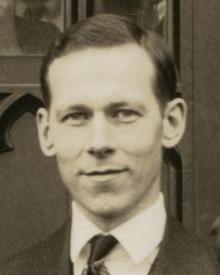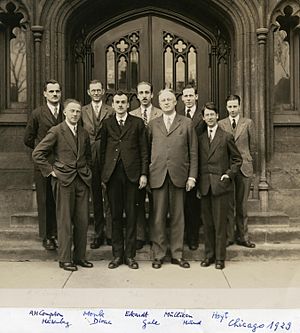Robert S. Mulliken facts for kids
Quick facts for kids
Robert Mulliken
|
|
|---|---|

Robert Mulliken, Chicago 1929
|
|
| Born |
Robert Sanderson Mulliken
June 7, 1896 |
| Died | October 31, 1986 (aged 90) Arlington, Virginia, U.S.
|
| Alma mater | MIT University of Chicago |
| Known for | Molecular orbital theory Quantum chemistry Mulliken electronegativity Mulliken population analysis |
| Awards |
|
| Scientific career | |
| Fields | chemistry, physics |
Robert Sanderson Mulliken (born June 7, 1896 – died October 31, 1986) was an American scientist. He was both a physicist and a chemist. Mulliken is best known for helping to create the molecular orbital theory. This theory explains how molecules are built and how their parts work together.
For his important work, Mulliken received the Nobel Prize in Chemistry in 1966. He also won the Priestley Medal in 1983.
Contents
Early Life and Education
Robert Mulliken was born in Newburyport, Massachusetts. His father, Samuel Parsons Mulliken, was a professor of organic chemistry at MIT. Robert was very good at remembering things, especially facts about plants. He learned German so well that he did not need to take the course in college.
He helped his father edit a big book about identifying organic compounds. This made Robert an expert in naming chemical compounds.
College Years
In 1913, Robert graduated from high school. He won a scholarship to MIT, just like his father had. He chose to study chemistry. While still in college, he did his first research. He worked on making organic chlorides.
He also took some chemical engineering classes. He spent a summer visiting chemical factories. In 1917, he earned his bachelor's degree in chemistry from MIT.
Starting His Career
When the United States entered World War I, Mulliken started working. He made poison gas for the government. He was later drafted into the Army's Chemical Warfare Service. He continued doing the same work.
After the war, he worked on how zinc oxide and carbon black affect rubber. But he soon realized this was not the kind of chemistry he wanted to do. So, in 1919, he began his Ph.D. studies at the University of Chicago.
Graduate Studies and Research
In 1921, Mulliken earned his doctorate degree. His research was about separating isotopes of mercury. He used a method called evaporation. At the University of Chicago, he took a class with the famous physicist Robert A. Millikan. This class introduced him to quantum theory.
Mulliken received a grant to continue his work on isotope separation. In 1923, he used the grant to study how isotopes affect the light given off by molecules. He went to Harvard University to learn about spectroscopy. This is a way to study light and matter. He also learned more about quantum theory there.
He met many future Nobel Prize winners at Harvard. These included J. Robert Oppenheimer and Harold C. Urey.
Travels to Europe and New Ideas
In 1925 and 1927, Mulliken traveled to Europe. He worked with many brilliant scientists. These included Erwin Schrödinger, Paul Dirac, and Werner Heisenberg. They were all developing new ideas in quantum mechanics.
Mulliken was especially influenced by Friedrich Hund. Hund was studying how quantum theory explained the light from molecules. Mulliken had been studying the same thing. In 1927, Mulliken worked with Hund. Together, they developed the molecular orbital theory. This theory says that electrons in a molecule belong to the whole molecule, not just one atom. Because of their work together, this theory was sometimes called the Hund-Mulliken theory.
Developing Molecular Orbital Theory
From 1926 to 1928, Mulliken taught physics at New York University. This showed that his work was important to both chemistry and physics. Later, he returned to the University of Chicago. He became a professor in both the physics and chemistry departments. He continued to improve his molecular orbital theory.
Before Mulliken's work, scientists used a different method to understand molecules. This was called the Valence-Bond (VB) method. It said that chemical bonds were like two atoms sharing electrons. This idea was popular because it matched how chemists thought about bonds.
However, the VB method did not always work well for all types of molecules. Mulliken and Hund's molecular orbital method was more flexible. It could explain many different kinds of molecules. This method became very important in chemistry. It helped scientists understand how molecules behave. Because of this major step forward, Mulliken won the Nobel Prize in Chemistry in 1966.
Mulliken became a member of the United States National Academy of Sciences in 1936. He was the youngest member at that time. He was also elected to other important scientific groups.
The method for figuring out the charges on atoms in a molecule is called Mulliken population analysis. It is named after him.
Personal Life
On December 24, 1929, Robert Mulliken married Mary Helen von Noé. She was the daughter of a geology professor at the University of Chicago. They had two daughters.
Later Years and Achievements
In 1934, Mulliken created a new way to measure how strongly an atom pulls electrons. This is called electronegativity. His scale was similar to one developed by Linus Pauling.
During World War II, from 1942 to 1945, Mulliken led an information office. This office was part of the Plutonium project at the University of Chicago. After the war, he worked on mathematical formulas. These helped to advance the molecular orbital theory even further.
In 1952, he started using quantum mechanics to study how acids and bases react. He became a distinguished professor in 1961. He continued to study the structure of molecules and how they interact with light.
Mulliken retired in 1985. His wife, Mary Helen, passed away in 1975.
Robert Mulliken died on October 31, 1986, at the age of 90. He passed away from heart failure at his daughter's home. He was buried in Chicago.
See also
 In Spanish: Robert S. Mulliken para niños
In Spanish: Robert S. Mulliken para niños
- Mulliken symbols
- Adiabatic electron transfer
- Bonding molecular orbital
- Delta bond
- Halogen bond
- Walsh diagram


